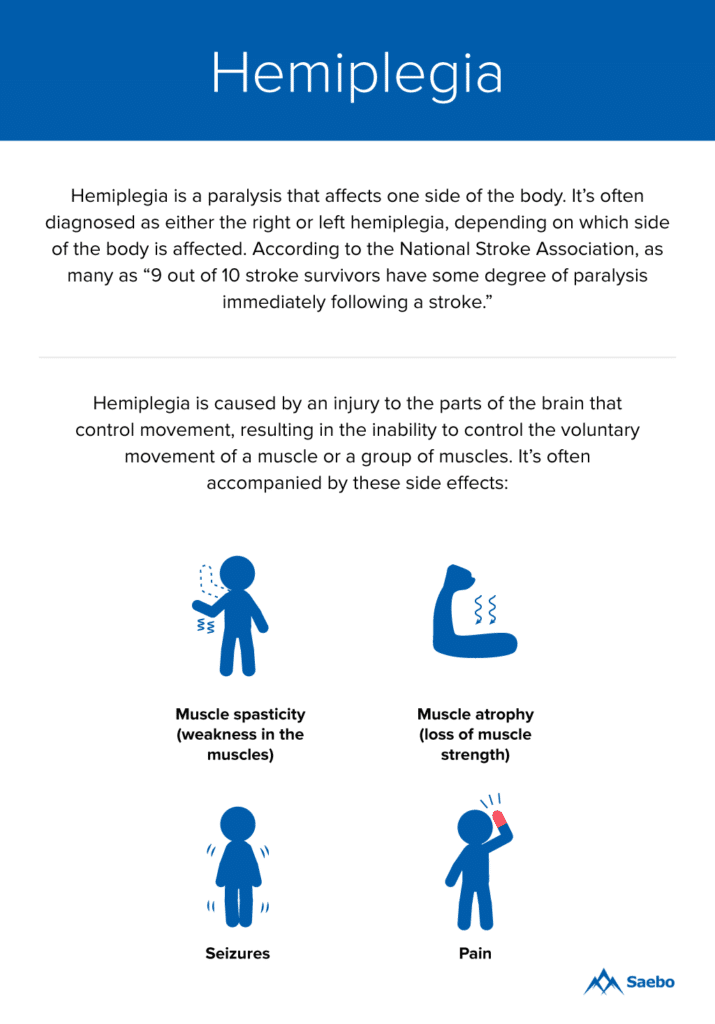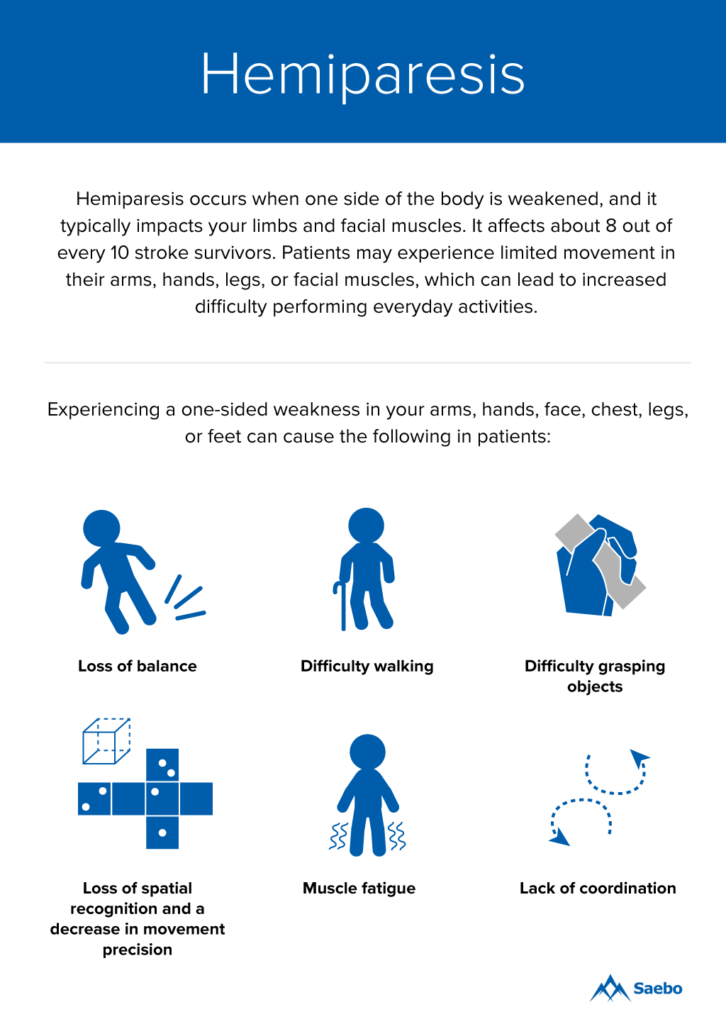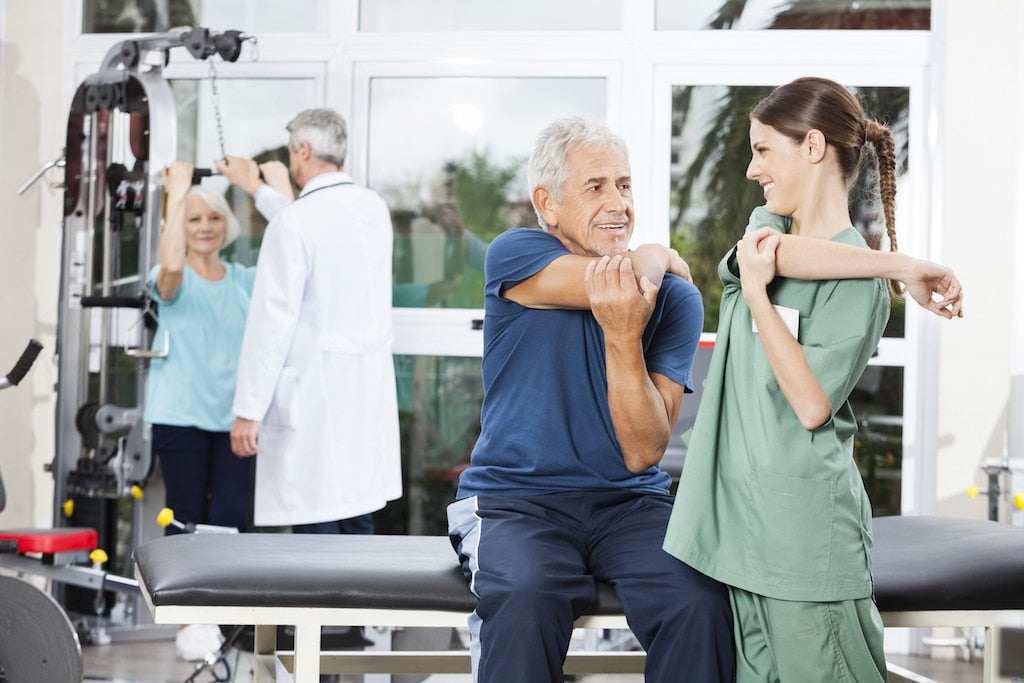Treating Hemiplegia and Hemiparesis After Stroke


After a stroke, it’s common to experience weakness or paralysis on one side of the body, depending on which side of the brain your stroke occurred. Right-sided weakness or paralysis is caused by an injury to the left side of the brain, where the areas that handle language and memory are. Left-sided weakness or paralysis is caused by an injury to the right side of the brain, which contains the areas that control facial recognition and nonverbal behavior.
Although hemiplegia and hemiparesis sound very similar—in fact, both derive from “hemi,” a Greek word that means half—they do have distinct differences. Let’s take a look at how each condition affects the brain and body.
Hemiplegia
Hemiplegia is a paralysis that affects one side of the body. It’s often diagnosed as either the right or left hemiplegia, depending on which side of the body is affected. According to the National Stroke Association, as many as “9 out of 10 stroke survivors have some degree of paralysis immediately following a stroke.”
Hemiplegia is caused by an injury to the parts of the brain that control movement, resulting in the inability to control the voluntary movement of a muscle or a group of muscles. It’s often accompanied by these side effects:
- Muscle spasticity (weakness in the muscles)
- Muscle atrophy (loss of muscle strength)
- Seizures
- Pain

Hemiparesis
Hemiparesis occurs when one side of the body is weakened, and it typically impacts your limbs and facial muscles. It affects about 8 out of every 10 stroke survivors. Patients may experience limited movement in their arms, hands, legs, or facial muscles, which can lead to increased difficulty performing everyday activities.
Experiencing a one-sided weakness in your arms, hands, face, chest, legs, or feet can cause the following in patients:
- Loss of balance
- Difficulty walking
- Difficulty grasping objects
- Loss of spatial recognition and a decrease in movement precision
- Muscle fatigue
- Lack of coordination

Treating Hemiplegia and Hemiparesis
Although hemiplegia and hemiparesis are serious handicaps, physical and occupational therapy and rehabilitation can help improve movement in those areas. Here are some of the techniques that aid in recovery.
Range-of-Motion Exercises
Range-of-motion exercises can help to prevent muscle stiffness and contractures by moving the weakened or paralyzed limb. Depending on whether the limb can voluntarily move or has to be moved by someone else, range-of-motion exercises can be passive (where someone else moves the limb for you), active-assistive (where you perform as much of the movement as possible with the help of someone else to complete the movement), or active (where you complete the movement).
Flexibility Training
After a stroke, your therapist will work with you to design a stretching program that will best suit your needs. Flexibility training improves blood circulation and can help you regain the balance and coordination that can be lost after a stroke. When paired with strength training, flexibility training can lead to improved posture and ability.
Flexibility training is important if you have limited mobility on your non-dominant side. Often, the muscles on your dominant side of your body will be more flexible, so working to keep your dominant side as flexible as possible can help to increase mobility on your non-dominant side.
Electrical Stimulation
Electrical stimulation has been used to strengthen muscles in the arm and improve range of motion in patients with hemiparesis. During electrical stimulation, small electrical pads are placed on the weakened muscles of the arm. A small electrical charge will trigger a shock to the muscles to make them contract while you work to move your arm.
There are several electrical stimulation devices that can be used at home and are also covered by insurance, such as the SaeboStim Micro and Saebo MyoTrac Infiniti.
Modified Constraint-Induced Therapy (mCIT)
During modified constraint-induced therapy (mCIT), therapists use focus exercises to increase movement in patients with hemiparetic arms. Patients attend this therapy three times a week, in half-hour sessions, over a 10-week period. Research has shown that mCIT can be useful in increasing the movement in an arm affected by hemiplegia, but only in patients who are able to move their wrists or fingers voluntarily.
Motor Imagery (MI)
During motor-imagery exercises, you will be asked to imagine yourself using a certain part of your body. As you imagine these body parts moving, certain areas of your brain and muscles may be active as if you were actually doing the activity. This mental practice has been shown to improve arm movement in patients with hemiparesis, and research suggests that motor-imagery exercises may be useful in helping patients walk.
Assistive Devices
Assistive devices, such as braces, canes, walkers, and wheelchairs, can increase strength and movement in patients with weakened or paralyzed limbs. Your physical therapist will recommend a device that best fits your needs; however, it’s important to be trained in the safety procedures and proper use of orthotics—including making sure the device is properly fitted and learning how to maintain it.
Mobility and Modifying Your Home
Although living with hemiplegia and hemiparesis can be difficult, it’s not impossible. Rehabilitation treatment and assistive devices can help increase mobility and work towards recovery. Additionally, there are a variety of home modifications—such as installing ramps and raised toilet seats—that can improve the safety of those with one-sided weakness or paralysis.
All content provided on this blog is for informational purposes only and is not intended to be a substitute for professional medical advice, diagnosis, or treatment. Always seek the advice of your physician or other qualified health provider with any questions you may have regarding a medical condition. If you think you may have a medical emergency, call your doctor or 911 immediately. Reliance on any information provided by the Saebo website is solely at your own risk.
All content provided on this blog is for informational purposes only and is not intended to be a substitute for professional medical advice, diagnosis, or treatment. Always seek the advice of your physician or other qualified health providers with any questions you may have regarding a medical condition. If you think you may have a medical emergency, call your doctor or 911 immediately. Reliance on any information provided by the Saebo website is solely at your own risk.




